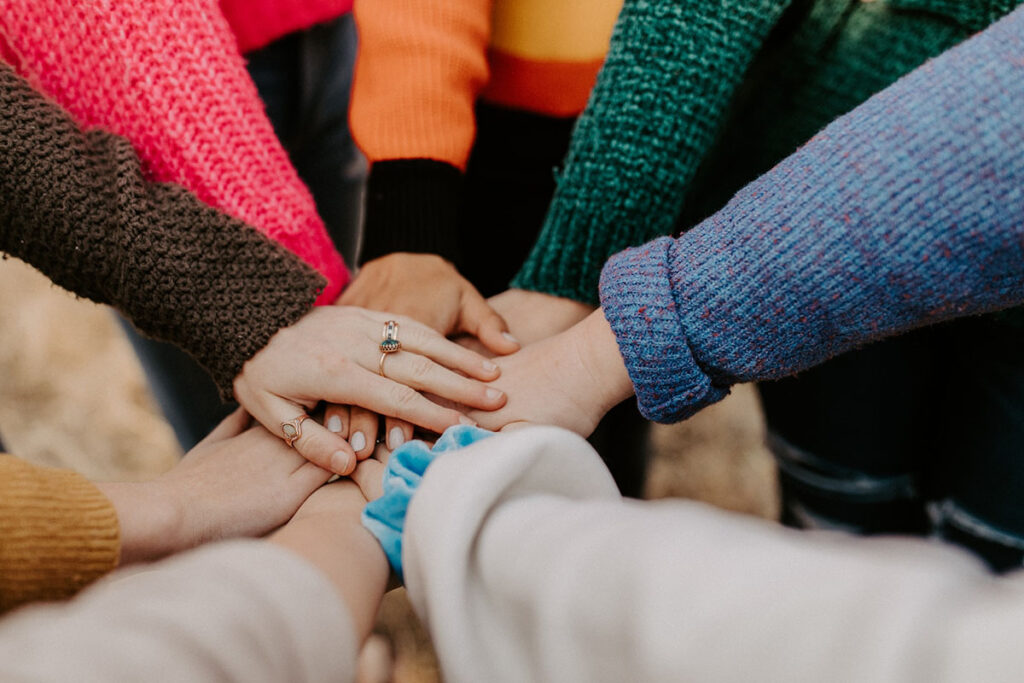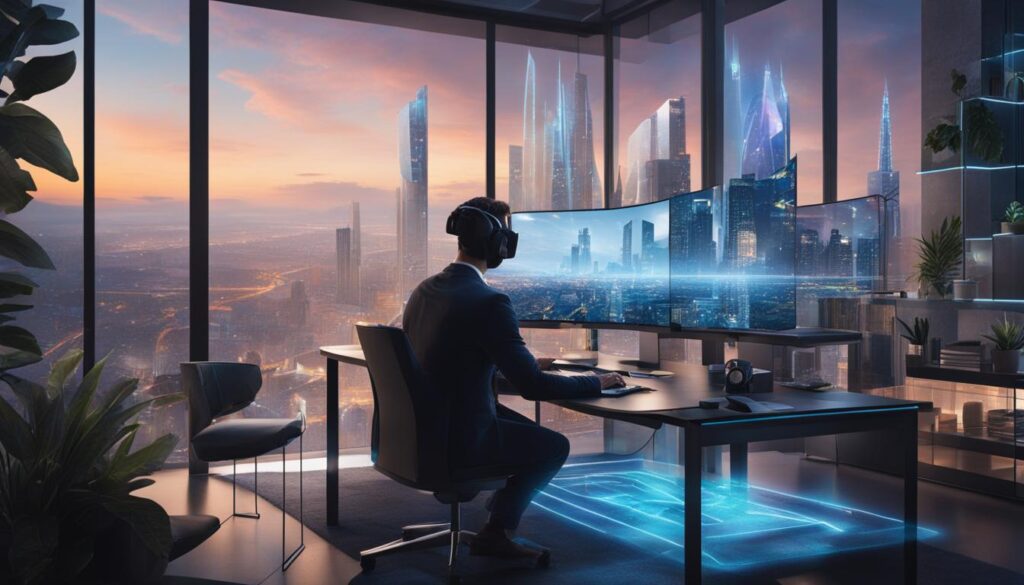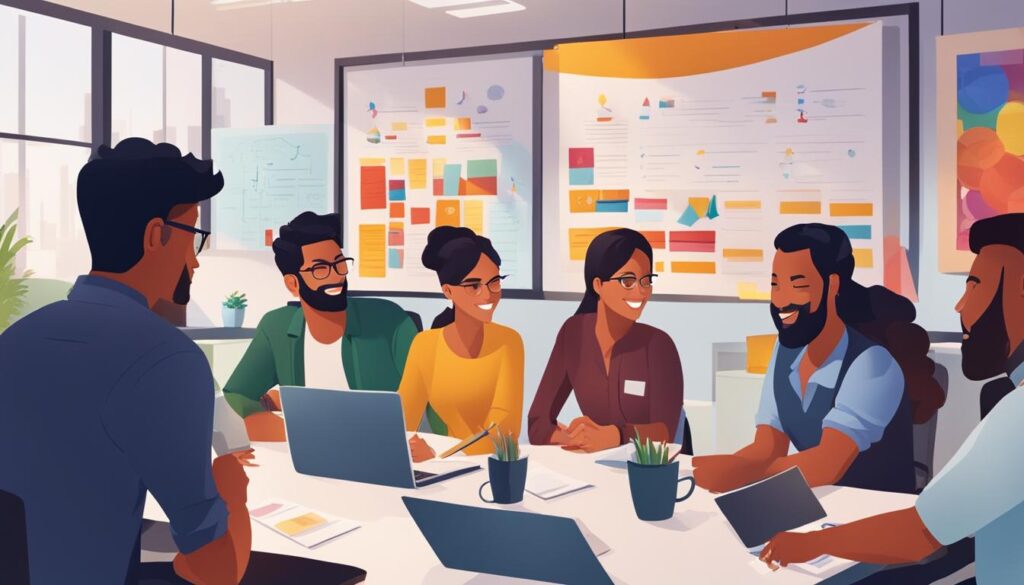According to the Society for Human Resource Management (SHRM), a huge1 67% of companies face conflicts between different ages at work1. Deloitte’s study shows that 60% of workers think their company doesn’t talk well to all ages1. The ADP Research Institute found that 58% of employees deal with age-related conflicts, mainly because of different ways of talking1.
As we move through the changing multigenerational workplace, it’s key to know how each age group likes to communicate. Baby boomers like talking face-to-face and on the phone2. Millennials prefer texting and instant messages2. These different ways of talking can cause misunderstandings and fights2.
Key Takeaways
- Intergenerational conflicts are common, with 67% of companies facing these issues1.
- It’s hard to talk well across ages, with 60% of workers saying their company doesn’t do it1.
- Different ways of talking, like baby boomers’ love for face-to-face and millennials’ love for digital, cause 58% of age-related conflicts21.
- Knowing how each age likes to communicate is key to a good work place23.
- Working on these communication issues can help make a diverse, multigenerational team work better21.
Understanding the Multigenerational Workplace Landscape
Today’s workplace is filled with people from different generations. Each group has its own way of communicating and working. By 2021, millennials were 35% of the U.S. workforce. Generation Z is expected to be 27% by 20304.
Baby Boomers, Generation X, Millennials, Generation Z, and Generation Alpha work together. This mix creates a dynamic and diverse work environment.
Key Characteristics of Each Generation
Each generation has its own communication style. Baby Boomers like talking face-to-face and using old ways to communicate. Millennials and Generation Z prefer digital tools like email and social media5.
Work values also differ by generation. For example, 70% of Millennials want a good work-life balance4. Meanwhile, 64% of Generation Z wants to work for a company with a strong social mission4.
Evolution of Workplace Communication Methods
Workplace communication has changed a lot. This change is thanks to new technology and younger workers. Companies that adjust their communication methods can improve teamwork and diversity5.

Understanding how each generation communicates helps. A flexible approach to communication can make teams more productive and happy5.
Statistics on Intergenerational Communication Workplace
Dealing with different communication styles in a multigenerational team is tough. LinkedIn says 89% of HR folks see this as a big problem6. Harvard Business Review also found 76% think these gaps slow down work6.
These gaps affect many parts of work. Ernst & Young found 65% of millennials think their company talks too much6. Also, 39% of UK bosses say staff face problems because of age7.
Digital tools make these issues worse. 90% of teams fight over digital tools6. This fight hurts teamwork and makes work slower, with 60% of teams agreeing6. Plus, 43% of teams get confused about tone or context online, and 33% get mixed up about how fast to respond or what emojis mean6.
There’s also a big gap in tech use. Gen Z is leading in AI, but only 12% of those over 50 use AI a lot6. This gap worries 67% of people, thinking AI will make age gaps bigger. And 70% think AI will help Gen Z move up faster in work6.
It’s key to fix these tech and talk problems to make work better for everyone. As work changes, companies need to find ways to help all ages work well together. They should focus on sharing knowledge, learning from each other, and solving conflicts.
Impact of Generational Diversity on Team Dynamics
Organizations are working hard to include all ages in their teams. This is important for success. A survey by Deloitte found that only 6% of leaders know how to manage teams of different ages well8.
Today, managers lead teams with up to five generations. Poor management can lead to age bias and lower performance8.
Collaboration Patterns Across Age Groups
Generational diversity affects how teams work together. Millennials and Generation Z make up a big part of the workforce9. Millennials prefer digital communication, which can be a challenge9.
It’s important to find ways to bridge these communication gaps. This helps teams work better together and share knowledge.
Performance Metrics in Mixed-Generation Teams
When managed right, diversity can be a big plus. Diverse teams are 35% more likely to outperform others9. Mentorship programs can also help, like at Unilever, where employee retention went up by 20%9.
But, bias and poor leadership can hurt team performance. This shows the need for training and development.
Conflict Resolution Statistics
Managing conflicts in diverse teams is key. The Society for Human Resource Management says 58% of companies face generational conflicts8. Training to reduce bias can increase employee engagement by 70% at Accenture9.
Using digital tools like IBM’s “CollabConnect” can also help. It boosts innovation across different ages9.

By embracing diversity, organizations can grow and innovate. They can unlock their team’s full potential89.
Digital Communication Preferences by Generation
Working with different ages in a team can be tricky. Each age group likes to communicate in their own way. It’s key to know and meet these needs.
Digital Natives, who grew up with the internet, love quick messages like texts and social media chats10. Digital Immigrants, who learned later, prefer emails and phone calls10.
Younger folks, like Millennials and Gen Z, like fast messages and emails11. They also use fun stuff like emojis and GIFs11. Older folks, like Baby Boomers and Gen X, like talking face-to-face or on the phone11.
It’s important to bridge these gaps for better teamwork. Teaching Digital Immigrants about digital tools10 and setting up mentor programs10 can help.
Using tools that mix text, email, and video can meet everyone’s needs10. Also, talking openly and working together can improve communication10.

As work changes, we must adapt to each generation’s way of communicating. By valuing both Digital Natives and Digital Immigrants, teams can work better together.
Knowledge Transfer Challenges Between Age Groups
Sharing knowledge between different ages in the workplace is tough. Only 12% of employees say their company uses their skills well12. We need better ways to share knowledge between ages and help with mentorship.
Barriers to Information Sharing
Age differences can stop people from sharing information and working together. Older workers like face-to-face talks, while younger ones prefer digital tools13. It’s important to find ways to bridge these gaps for better sharing.
Success Rates of Mentorship Programs
Mentorship can help connect different ages and share knowledge. 83% of millennials with mentors are engaged at work12. But, these programs need support, good matches, and clear goals to succeed.
Technology Adoption Gaps
Different ages have different tech comfort levels, making sharing hard. Younger workers easily use new tech, but older ones might find it hard13. Training can help everyone use tech for better sharing.
| Generation | Technology Adoption and Communication Preferences |
|---|---|
| Traditionalists/Silent Generation | Value in-person communication, may struggle with new technologies13 |
| Baby Boomers | Comfortable with both traditional and digital communication, can adapt to new technologies13 |
| Generation X | Familiar with both traditional and modern communication methods13 |
| Millennials | Prefer using technology for communication and idea sharing13 |
| Generation Z | Digital natives, highly adaptable to new communication tools and technologies13 |
Knowing what each generation likes can help companies share knowledge better. This way, they can help with mentorship and close the age gaps at work.

Workplace Communication Style Differences
In today’s workplace, it’s key to bridge age gaps and manage multigenerational workforce dynamics well. Each generation has its own way of communicating, shaped by the tech and media of their youth14.
Baby Boomers like talking on the phone, while Generation X prefers seeing things in pictures14. Millennials like texting and instant messaging. Generation Z goes for the quickest ways to talk14.
These differences can cause misunderstandings at work. For example, 83% of Gen Z emoji users use emojis to show feelings. Older folks might prefer writing in a formal way14.
Also, different generations have different views on work and life. Baby Boomers are 15% more likely to apply for remote jobs. Gen Zers and Millennials want to keep their work and life balanced14.
It’s important to understand these communication differences. We need to find ways to work together better in a multigenerational workforce15.
| Generation | Communication Preference |
|---|---|
| Baby Boomers | Auditory, phone calls |
| Generation X | Visual, prefers making phone calls |
| Millennials | Text-based, instant messaging |
| Generation Z | Fastest communication methods, emojis |

Cross-Generational Mentoring Success Rates
Breaking down generational barriers is key to better work communication. Studies reveal that companies with intergenerational mentoring see a 23% boost in performance16. Also, 70% of workers want a mentor, with 55% looking for someone from a different generation16.
Traditional vs Reverse Mentoring Outcomes
Good mentorship programs help keep employees. A big tech company saw better teamwork and talk after starting a mentoring program16. IBM’s reverse mentoring cut millennial turnover by 42%16.
Impact on Employee Retention
Mentoring across generations boosts engagement and keeps people around. Companies with mentoring see a 20% jump in employee interest16. Also, those in mentorship are five times more likely to get promoted16. Plus, 67% of older workers with mentors plan to stay longer16.
| Mentoring Outcomes | Impact |
|---|---|
| Increase in overall performance and productivity | 23%16 |
| Decrease in turnover rates among millennial employees | 42%16 |
| Increase in employee engagement | 20%16 |
| Increase in likelihood of being promoted | 5x16 |
| Increase in likelihood of staying longer in the workforce for workers over 50 | 67%16 |

Creating a space for all ages to talk and work together is crucial. It makes the workplace better and more productive. As work changes, cross-generational mentoring is a smart move for success16.
Technology Adoption and Communication Tools
In today’s fast-changing workplace, it’s key to use each generation’s strengths. This helps in better communication and teamwork17. Studies found that 77% of people feel closer to their grandparents or grandkids when they talk openly. Also17, 60% of millennials say talking to older people makes them better communicators.
Companies are using new tech to meet the needs of all ages in their teams17. Those who teach how to talk across generations see a 15% jump in happiness and a 10% boost in getting things done. Tools like project management software and virtual meeting spaces make it easier for everyone to share ideas and work together18. McKinsey & Company found that teams with different ages do 35% better than others, showing the power of using each generation’s skills.
Technology has changed how we talk to each other17. Almost all teens in the U.S. have a smartphone, and17 73% of baby boomers like texting and using social media to talk to their grandkids18. Accenture’s study showed that 73% of older adults who use social media feel more connected, proving tech’s good side for family ties.
As work changes, companies that use tech to bring generations together will lead the way. They’ll use the talents of all ages to innovate and succeed18. Deloitte’s study found that teams that work together across ages are 20% more creative than others.

Building Bridges: Effective Communication Strategies
In today’s workplace, five generations19 work together. Companies face the challenge of bridging communication gaps. Research shows 60% of employees see generational differences as a cause of workplace conflict19.
Organizations are now using targeted training and best practices. They aim to improve communication between generations. This makes the workplace more inclusive for everyone.
Training Program Effectiveness
Generational diversity training is proving to be effective. 70% of employees say it helps teamwork and collaboration19. These programs teach employees to adapt to different communication styles.
For example, 74% of Baby Boomers, 87% of Gen X, and 95% of Millennials prefer digital platforms for work talks19.
Best Practices for Integration
Companies are also exploring other ways to integrate diverse communication styles. Mentorship programs19 are showing positive results. 59% of employees find them helpful for improving communication skills19.
Creating open dialogue forums and tailoring communication to age groups also works well20.
Encouraging cross-generational interactions and team-building activities helps unite the workforce20. Challenging age-related stereotypes and biases creates an inclusive culture. This makes everyone feel valued and heard20.
With 57% of employees wanting more diversity, these efforts improve collaboration and team dynamics19. This leads to better business performance19.

| Outcome | Percentage |
|---|---|
| Employees believe effective communication is the most important factor for a collaborative workplace | 75%19 |
| Employees believe communication barriers across generations result in conflicts within the workplace | 56%19 |
| Organizations believe intergenerational communication is a challenge in the workplace | 72%19 |
| Employees believe their company should be doing more to increase diversity | 57%19 |
| Millennial employees prefer regular feedback from their managers | 65%19 |
| Companies with inclusive cultures are more likely to outperform their industry peers | 80%19 |
By using these strategies, organizations can bridge the generational gap20. They can create a more collaborative and inclusive work environment. This drives business success192021.
Measuring ROI of Intergenerational Programs
Organizations aim to improve conflict resolution, intergenerational collaboration, and workplace inclusivity. It’s key to measure the return on investment (ROI) of their efforts. Deloitte found that diverse and inclusive teams outperform others by about 35%22.
Gallup reports that teams with engagement across generations are 21% more profitable22.
Improvements in productivity, employee satisfaction, and success are important metrics. These show the value of intergenerational programs22. By promoting collaboration and understanding, companies can grow and succeed.
- Checking job descriptions for ageist language and using blind resume screening helps fight ageism in hiring22.
- Creating phased retirement options, part-time consulting contracts, and mentorship roles keeps older workers22.
- Providing tiered learning options and incentivizing peer-to-peer tech support helps with tech comfort differences22.
To support age inclusion, linking it to retention and productivity is essential22. Overcoming resistance requires empathy, not blame. Workshops and safe spaces for dialogue are helpful22.
Age-inclusive communication must start with leaders22.
By measuring the ROI of intergenerational programs, organizations can tap into their diverse workforce’s potential. This leads to better conflict resolution, intergenerational collaboration, and workplace inclusivity22.

Remote Work Impact on Generational Communication
The move to remote work has made good communication between generations more important. A big number of Gen Z and Millennials like working from home more than offices. They say it helps them balance work and life better23. But, working from home can also be lonely, with 37% of remote workers feeling left out23.
Virtual Collaboration Statistics
Remote work has changed how we work together, and different ages have adapted differently. Gen Z thinks working from home makes them more productive because it’s less distracting. On the other hand, 73% of Baby Boomers are okay with using video calls for work23. It’s also good for relationships, with 75% of millennials saying they get along better with older coworkers now23.
Adaptation Rates by Age Group
Remote work has brought new ways to communicate that fit what each generation likes. Baby Boomers still like meeting in person, but 81% of Gen Z wants to work in flexible ways23. Also, 60% of workers think remote work helps them learn from people of different ages. And 66% of Gen Z feels okay asking for advice from older coworkers online23.
As work changes, it’s key for companies to know what each generation needs to work well together from home24.

Leadership Approaches for Mixed-Generation Teams
Effective leadership in mixed-generation teams means recognizing each generation’s strengths. Leaders who foster a culture of respect for diverse perspectives and encourage open dialogue have seen improved team performance.25 Training on communication strategies for different generations boosts collaboration and productivity25.
Organizations must recognize the unique contributions of Baby Boomers, Generation X, Millennials, and Generation Z26. Leaders in intergenerational settings need to be flexible and adaptable. They must fit the varied job preferences, communication methods, and values of each age group26.
Adjusting management strategies to meet the diverse expectations of generations can improve employee engagement and satisfaction26. This approach, along with promoting respect and open communication, can unlock the full potential of mixed-generation teams. It helps bridge the generational divides in the workplace.

Fostering an age-inclusive culture is key for mixed-generation team success. Leaders must tackle biases and stereotypes to promote diversity and inclusion25. By using the unique strengths and perspectives of each generation, organizations can create a dynamic and innovative workforce. This workforce thrives on the synergy of diverse experiences and skill sets.
Future Trends in Workplace Demographics
The workforce is changing fast. By 2030, Generation Z will be 27% of the global workforce27. This means five generations could work together soon27. This change makes intergenerational collaboration key and shows the need for a diverse workforce.
This shift brings both challenges and chances for companies. Knowing each generation’s characteristics and communication preferences is vital28. It helps in managing multigenerational teams and creating an inclusive culture28.
As the workforce changes, companies must act. They need to create special training, mentorship, and communication tools28. This helps bridge the gap and makes intergenerational collaboration work better.
| Generation | Birth Year | Estimated U.S. Population |
|---|---|---|
| Traditionalists | Before 1946 | N/A |
| Baby Boomers | 1946 – 1964 | 65.2 million |
| Generation X | 1965 – 1980 | 65.2 million |
| Millennials | 1981 – 1996 | N/A |
| Generation Z | 1997 – 2012 | N/A |
Companies must be ready to adapt as the workforce changes28. By valuing each generation’s strengths, they can create a better workplace28. This leads to a more inclusive, productive, and innovative work environment.

Organizations should watch the workforce closely and adjust their plans29. They might offer flexible work, use age-inclusive technology, and celebrate all employees’ contributions29. This way, they can thrive in the evolving workplace of the future.
Creating an Age-Inclusive Communication Culture
Creating a culture that welcomes all ages is key for a successful team. Using many ways to talk and teaching about age differences helps everyone respect and work together30. This makes teams better at sharing ideas and working together31.
Implementation Strategies
Good communication cultures use many ways to talk, like meetings and emails32. This helps everyone, no matter their tech skills, to join in. Programs that pair older and younger workers help them learn from each other32.
Activities that mix ages help everyone get along better32. Workplaces should have things like gyms and quiet spots for everyone’s needs32.
Success Metrics
Success is seen in happy workers, less arguing, and more sharing of ideas3031. Companies that value age diversity are more creative and engaged31.
By valuing age diversity, businesses can make the most of their teams32.

Conclusion
Understanding generational differences at work is key to a happy and productive workplace. By using smart strategies, companies can use the best of each generation. This leads to new ideas and teamwork33.
The future of work is about closing these gaps. We need places where everyone’s views are valued. This makes work better for everyone.
Programs like intergenerational mentoring programs and reverse mentoring initiatives help a lot. They help share knowledge and improve talking between people of different ages33. When we help our employees grow, everyone wins.
Companies that want a diverse team should look into new learning tools. Tools like GyrusAim can really help. It offers many ways to learn, fitting the needs of every age. This makes the whole team stronger.
Source Links
- Addressing Intergenerational Communication Challenges in the Modern Workplace – https://vorecol.com/blogs/blog-addressing-intergenerational-communication-challenges-in-the-modern-workplace-8315
- Enhancing Intergenerational Communication – https://executive.berkeley.edu/thought-leadership/blog/enhancing-intergenerational-communication
- Intergenerational Communication in the Workplace – https://www.octanner.com/articles/creating-and-communicating-culture-for-an-intergenerational-workforce
- The multigenerational workplace – https://lmwgroup.com/the-multigenerational-workplace/
- Addressing Communication Styles Across Different Generations – https://vorecol.com/blogs/blog-addressing-communication-styles-across-different-generations-9992
- Digital tools cause intergenerational conflict at work, research suggests – HR Magazine – https://www.hrmagazine.co.uk/content/news/digital-tools-cause-intergenerational-conflict-at-work-research-suggests/
- Multigenerational workforce suffers from collaboration difficulties – HR Magazine – https://www.hrmagazine.co.uk/content/news/multigenerational-workforce-suffers-from-collaboration-difficulties/
- Why We Need Intergenerational Friendships at Work – https://hbr.org/2024/03/why-we-need-intergenerational-friendships-at-work
- How do generational differences impact collaboration and innovation in team dynamics? – https://vorecol.com/blogs/blog-how-do-generational-differences-impact-collaboration-and-innovation-in-team-dynamics-148185
- Intergenerational Communication: Bridging the Gap Between Digital Natives and Digital Immigrants – https://medium.com/@the.millennial.report.31/intergenerational-communication-bridging-the-gap-between-digital-natives-and-digital-immigrants-762105c517ee
- Best Communication Strategies for a Multigenerational Workforce – https://seb-admin.com/blog/best-communication-strategies-for-a-multigenerational-workforce/
- How to manage a multigenerational workforce: Top challenges, best practices and tips – https://www.culturemonkey.io/employee-engagement/multigenerational-workforce/
- Managing a Multigenerational Workplace: Challenges and Opportunities – Diversio – https://diversio.com/managing-multigenerational-workplace/
- A Guide to Leading an Effective Multi-Generational Workforce – https://www.shrm.org/enterprise-solutions/insights/guide-to-leading-multi-generational-workforce
- Emotional Intelligence Can Improve Communication Between Generations in the Workplace – https://situational.com/blog/emotional-intelligence-can-improve-communication-between-generations-in-the-workplace/
- Strategies for Mentoring and Developing Intergenerational Talent – https://vorecol.com/blogs/blog-strategies-for-mentoring-and-developing-intergenerational-talent-9993
- Navigating Intergenerational Communication in the Digital Age – https://vorecol.com/blogs/blog-navigating-intergenerational-communication-in-the-digital-age-11012
- Leveraging Technology to Bridge Generational Gaps in the Workplace – https://vorecol.com/blogs/blog-leveraging-technology-to-bridge-generational-gaps-in-the-workplace-10223
- Implementing Effective Communication Strategies Across Generations in the Workplace – https://vorecol.com/blogs/blog-implementing-effective-communication-strategies-across-generations-in-the-workplace-7626
- Building Bridges: Leading Across Generations in the Workplace – https://www.linkedin.com/pulse/building-bridges-leading-across-generations-workplace-mark-williams-ebunc
- Communicating Across Generations: Building Connections for Cohesive Workplace | Event Leadership Institute – https://eventleadershipinstitute.com/courses/training/intergenerational-communication-three-part-series-course/
- Age Diversity For Workplace Success | HR’s Inclusive Toolkit – https://hackinghrlab.io/blogs/workplace-age-diversity-strategies/
- The Impact of Remote Work on Generational Dynamics in the Workplace – https://vorecol.com/blogs/blog-the-impact-of-remote-work-on-generational-dynamics-in-the-workplace-11282
- The Impact of Remote Work on Generational Diversity Management – https://vorecol.com/blogs/blog-the-impact-of-remote-work-on-generational-diversity-management-9989
- Managing a Multi-Generational Workforce: A Comprehensive Guide for HR Professionals | Disclo Resource – https://www.disclo.com/resources/managing-a-multi-generational-workforce-a-comprehensive-guide-for-hr-professionals
- Importance of Intergenerational Leadership in Organizations – https://scholars.unh.edu/cgi/viewcontent.cgi?article=1132&context=ms_leadership
- Generational Diversity in the Workplace – Case Management Society of America – https://cmsatoday.com/2023/12/04/generational-diversity-in-the-workplace/
- Intergenerational Diversity and Inclusion Create a Harmonious Workplace – https://marketscale.com/industries/business-services/the-people-business-intergenerational-diversity-and-inclusion-create-a-harmonious-workplace/
- A closer look into the shifting dynamics of the workplace – Ragan Communications – https://www.ragan.com/by-the-numbers-workplace-trends/
- Age Bias at Work? Discover What You Need to Know… – https://blog.ulliance.com/age-bias-work-discover-what-you-need-know
- Why do employers need a partner to create and embrace an age-inclusive workplace? – SmartBrief – https://www.smartbrief.com/original/employers-need-partner-age-inclusive-workplace
- How to Create a Multigenerational Workplace – https://www.gensler.com/blog/how-to-create-a-multigenerational-workplace
- Multigenerational Training Workforce: A Comprehensive Guide – https://www.gyrus.com/blogs/multigenerational-training-workforce-a-comprehensive-guide





